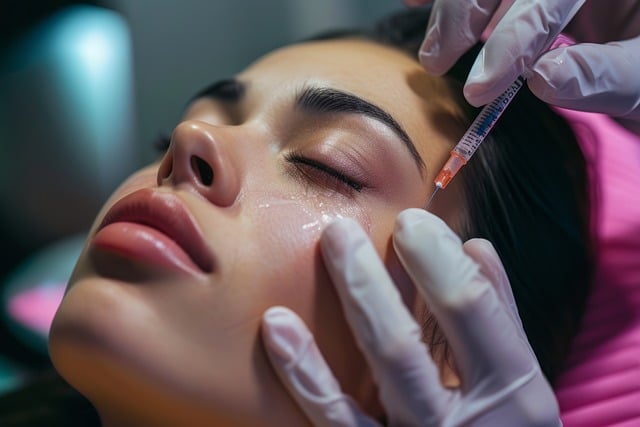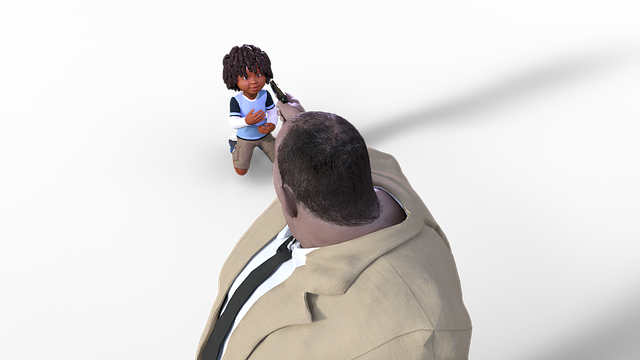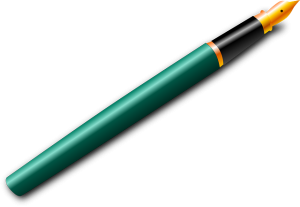Forehead wrinkles can be reduced through Botox or dermal fillers, each addressing dynamic wrinkles differently. Botox paralyzes facial muscles, preventing wrinkle formation and offering a natural, subtle enhancement lasting 3-6 months. Dermal fillers add volume by boosting skin elasticity, providing immediate yet temporary results that last up to several years. Choosing between them depends on individual needs: Botox for mild, expression-related wrinkles; dermal fillers for more significant, static lines. Consulting a dermatologist ensures the best option based on wrinkle severity and desired outcome.
“Unwanted forehead wrinkles can be a source of concern for many, leading to a quest for effective treatment options. This article delves into the world of cosmetic enhancements, focusing on customized Botox and dermal fillers as solutions for addressing forehead lines. We explore the underlying causes of these wrinkles and how Botox injections and dermal fillers offer distinct approaches to achieving a smoother forehead. By comparing these two popular treatments, we provide insights into their procedures, benefits, risks, and help you decide which method aligns best with your aesthetic goals, considering the latest trends in skincare.”
Understanding Forehead Wrinkles: Causes and Concerns

Forehead wrinkles, often a sign of aging or facial expressions, can be a source of concern for many individuals seeking smoother, more youthful-looking skin. Understanding the causes and available treatment options is essential when considering cosmetic procedures like Botox or dermal fillers. These non-surgical treatments have gained popularity due to their effectiveness in reducing the appearance of wrinkles and fine lines.
The primary cause of forehead wrinkles is a combination of factors including facial muscle movement, skin elasticity, and collagen production. Over time, repeated muscular contractions can lead to the formation of dynamic wrinkles, especially in areas like the brow and forehead. When considering Botox vs dermal fillers, it’s crucial to differentiate between their mechanisms. Botox temporarily paralyzes muscles, preventing them from causing wrinkle formation, while dermal fillers enhance skin volume by adding substances beneath the surface, plumping up depressed areas. Each treatment has its advantages and may be recommended based on individual concerns and skin types.
The Role of Botox in Treating Forehead Lines

Botox has emerged as a popular and effective treatment for forehead wrinkles, offering a non-invasive approach to achieving a smoother, more youthful appearance. Unlike dermal fillers, which are injected into the skin to add volume and fill in lines, Botox works by temporarily paralyzing the muscles responsible for causing dynamic wrinkles, particularly those associated with frowning or squinting.
The advantage of Botox over dermal fillers lies in its ability to target specific muscle groups, providing precise results. It is particularly effective for treating expression lines and furrows that form as a result of regular facial movements. While dermal fillers can enhance the skin’s appearance by adding volume, Botox focuses on reducing the depth and visibility of wrinkles, making it an excellent choice for those seeking a subtle yet noticeable improvement in their forehead contour.
Dermal Fillers: An Alternative Approach

While Botox has long been the go-to treatment for forehead wrinkles, dermal fillers offer a compelling alternative. Unlike Botox, which relaxes muscles to prevent wrinkle formation, dermal fillers enhance volume and lift skin by plumping areas that have lost elasticity over time. This makes them an excellent option for individuals seeking a more immediate and sustained result in terms of smoothing out existing wrinkles.
The key difference between Botox vs Dermal Fillers lies in their mechanism of action. Botox targets the underlying muscles, whereas dermal fillers work on the surface by adding volume. Both treatments have their advantages and disadvantages. Botox is often preferred for subtle corrections and temporary relief, while dermal fillers are ideal for more pronounced wrinkles and longer-lasting effects. The choice between the two ultimately depends on individual goals, skin type, and lifestyle considerations.
Comparing Botox and Dermal Fillers for the Forehead

When considering treatments for forehead wrinkles, a key debate revolves around Botox vs Dermal Fillers. Both options offer effective ways to reduce the appearance of lines and creases on the forehead, but they operate through different mechanisms. Botox injections temporarily paralyze muscles, preventing them from contracting and causing wrinkles. This method provides a subtle, natural-looking result that lasts for several months. On the other hand, dermal fillers enhance the skin’s volume by smoothing out indentations caused by wrinkles. They offer a more immediate effect but may require repeat treatments every few months to maintain results.
Choosing between Botox and dermal fillers depends on individual preferences and goals. Botox is ideal for those seeking a subtle, natural enhancement that reduces dynamic wrinkling caused by facial expressions. Dermal fillers, in contrast, are more suitable for patients aiming for a more dramatic, immediate smoothing effect. Consulting with a qualified dermatologist can help determine the best option based on the severity of wrinkles and desired outcome.
Procedure, Benefits, and Risks: A Comprehensive Look

The procedure for customized Botox treatment involves a simple, non-invasive process where small injections are administered to target specific muscles responsible for causing forehead wrinkles. A qualified healthcare professional will carefully assess your facial structure and skin quality to determine the optimal dosage and injection sites. This precision ensures effective results while minimizing the risk of unwanted side effects.
One of the key benefits of Botox over dermal fillers is its ability to offer a more natural-looking result, as it relaxes muscles rather than adding volume. It’s an excellent choice for subtle improvements, providing a youthful glow without dramatic changes. Moreover, Botox has a proven track record for safety and minimal downtime, making it a popular and effective solution for those seeking to reduce forehead wrinkles. However, like any procedure, there are risks involved, such as temporary bruising or discomfort at the injection sites. Choosing a reputable provider who uses sterile techniques can significantly lower these risks.
Choosing the Right Treatment: Factors to Consider

When considering customized treatments for forehead wrinkles, making an informed decision between Botox and dermal fillers is crucial. Both offer significant improvements in skin texture but cater to different needs. Factors like your age, skin type, and specific wrinkle pattern play a vital role. For instance, Botox is particularly effective for dynamic wrinkles caused by facial expressions, while dermal fillers are more suited for static lines resulting from aging.
Additionally, the duration of results varies between the two. Botox typically lasts 3-6 months, making it ideal for regular touch-ups, whereas dermal fillers can provide longer-lasting results, anywhere from 6 months to several years, depending on the type used. Your budget and desired outcome should also guide your choice, as these factors will determine the best option for achieving youthful-looking skin while ensuring safety and effectiveness.
